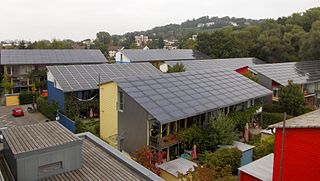
Appropriate technology is a movement encompassing technological choice and application that is small-scale, affordable by its users, labor-intensive, energy-efficient, environmentally sustainable, and locally autonomous. It was originally articulated as intermediate technology by the economist Ernst Friedrich "Fritz" Schumacher in his work Small Is Beautiful. Both Schumacher and many modern-day proponents of appropriate technology also emphasize the technology as people-centered.
Environmental design is the process of addressing surrounding environmental parameters when devising plans, programs, policies, buildings, or products. It seeks to create spaces that will enhance the natural, social, cultural and physical environment of particular areas. Classical prudent design may have always considered environmental factors; however, the environmental movement beginning in the 1940s has made the concept more explicit.

The open-design movement involves the development of physical products, machines and systems through use of publicly shared design information. This includes the making of both free and open-source software (FOSS) as well as open-source hardware. The process is generally facilitated by the Internet and often performed without monetary compensation. The goals and philosophy of the movement are identical to that of the open-source movement, but are implemented for the development of physical products rather than software. Open design is a form of co-creation, where the final product is designed by the users, rather than an external stakeholder such as a private company.

Environmental technology (envirotech) is the use of engineering and technological approaches to understand and address issues that affect the environment with the aim of fostering environmental improvement. It involves the application of science and technology in the process of addressing environmental challenges through environmental conservation and the mitigation of human impact to the environment.

Sustainable architecture is architecture that seeks to minimize the negative environmental impact of buildings through improved efficiency and moderation in the use of materials, energy, development space and the ecosystem at large. Sustainable architecture uses a conscious approach to energy and ecological conservation in the design of the built environment.

Microgeneration is the small-scale production of heat or electric power from a "low carbon source," as an alternative or supplement to traditional centralized grid-connected power.

Engineers for a Sustainable World (ESW) is a not-for-profit network headquartered in Pittsburgh, PA, USA. ESW is an umbrella organization with chapters established at over 50 colleges, universities, and city chapters located primarily in the United States and Canada ESW members work on technical design projects that have a focus on sustainability and environmental issues. Projects can be located either on-campus, in the local community, or internationally. Chapters are made up of students or professionals and are semi-autonomous.

A Zero-Energy Building (ZEB), also known as a Net Zero-Energy (NZE) building, is a building with net zero energy consumption, meaning the total amount of energy used by the building on an annual basis is equal to the amount of renewable energy created on the site or in other definitions by renewable energy sources offsite, using technology such as heat pumps, high efficiency windows and insulation, and solar panels.
The Appropriate Infrastructure Development Group (AIDG) provided access to environmentally friendly infrastructure in impoverished communities in developing countries through a combination of business incubation, education, and direct outreach. The AIDG's focus is the promotion of affordable and environmentally sound technologies to address gaps in basic services and infrastructure in rural areas of developing countries. The AIDG incubates businesses that provide renewable energy, water, and sanitation technologies to underserved communities, development agencies, and private individuals. The AIDG offers developing world design experience for university students interested in appropriate technology while providing hands-on assistance to rural communities in need.
The Office of Energy Efficiency and Renewable Energy (EERE) is an office within the United States Department of Energy. Formed from other energy agencies after the 1973 energy crisis, EERE is led by the Assistant Secretary of Energy Efficiency and Renewable Energy, who is appointed by the president of the United States and confirmed by the U.S. Senate. Alejandro Moreno currently leads the office as the Acting Assistant Secretary.

The developing nations of Africa are popular locations for the application of renewable energy technology. Currently, many nations already have small-scale solar, wind, and geothermal devices in operation providing energy to urban and rural populations. These types of energy production are especially useful in remote locations because of the excessive cost of transporting electricity from large-scale power plants. The applications of renewable energy technology has the potential to alleviate many of the problems that face Africans every day, especially if done in a sustainable manner that prioritizes human rights.

iDE, formerly International Development Enterprises, is an international nonprofit organization that promotes a business approach to increasing income and creating livelihood opportunities for poor rural households. iDE was founded in 1982 by Paul Polak, a Denver, Colorado psychiatrist who promoted the concept of helping poor people become entrepreneurs instead of simply giving them handouts. Originally, iDE was devoted to the manufacture, marketing, and distribution of affordable, scalable micro-irrigation and low-cost water recovery systems throughout the developing world. iDE facilitates local manufacture and distribution of these products through local supply chains that sell to farmers at an affordable price which they can repay in one growing season. This strategy allows farmers to grow higher value and surplus crops, and in turn links them to high-value crop markets where they can realize profits from their higher yields. Recently, their success is in the promotion of sanitation products to decrease the practice of open defecation leading to diarrheal disease.
The Lemelson Foundation is an American 501(c)(3) private foundation. It was started in 1993 by Jerome H. Lemelson and his wife Dorothy. The foundation held total net assets of US$444,124,049 at the end of 2020 and US$484,432,021 at the end of 2021. The Foundation seeks to harness the power of invention and innovation to accelerate climate action and improve lives around the world.
This page is an index of sustainability articles.
Nusantara Development Initiatives (NDI) is a nonprofit social enterprise that focuses on women, technology, and social impact. Its flagship program, Program Rumah Terang Nusantara (Mothers of Light Program), aims to end energy poverty and create growth in Indonesian villages by training rural women to become solar lamp entrepreneurs.
Lifeline Energy is a non-profit social enterprise that provides technology solutions for off-grid learning. The organization designs, manufactures and distributes solar and wind-up media players and radios for classroom and group listening and was behind the first solar and wind-up radio for humanitarian use which launched in 2003. Since it began operations in 1999 more than 550,000 wind-up and solar powered radios and media players have been distributed, mainly in sub-Saharan Africa. Millions of listeners have been reached, as classrooms of up to 60 children or listening groups can use each radio or media player.
Open-source appropriate technology (OSAT) is appropriate technology developed through the principles of the open-design movement. Appropriate technology is technology designed with special consideration for the environmental, ethical, cultural, social, political, and economic aspects of the community it is intended for. Open design is public and licensed to allow it to be used, modified, and distributed freely.
Environmentally sustainable design is the philosophy of designing physical objects, the built environment, and services to comply with the principles of ecological sustainability and also aimed at improving the health and comfort of occupants in a building. Sustainable design seeks to reduce negative impacts on the environment, the health and well-being of building occupants, thereby improving building performance. The basic objectives of sustainability are to reduce the consumption of non-renewable resources, minimize waste, and create healthy, productive environments.

The Stanford Woods Institute for the Environment serves as Stanford University's environmental studies hub for faculty. An interdisciplinary research lab, Woods encompasses senior fellows and affiliated faculty as well as researchers, postdoctoral scholars, and students collaborating on sustainability research. It supports research in seven areas: climate, ecosystem services and conservation biology, food security, freshwater, oceans, public health, and sustainable development. It provides seed funding for environmental research and supports seven research centers, programs and workshops. In September 2022, it became part of the Stanford Doerr School of Sustainability.
















